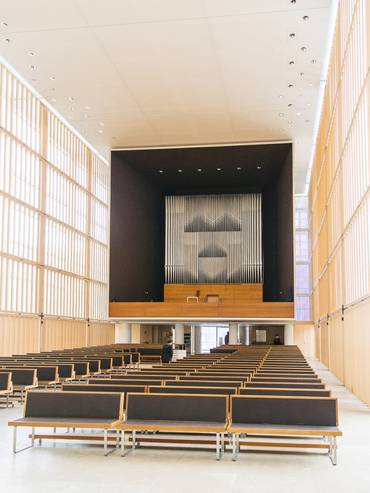Munich travel guide
Architecture
Head north to the stadiums embedded in the hilly landscape of Olympiapark and the four cylinders that make up the BMW headquarters, or walk between the contemporary cubes of Pinakothek der Moderne and Museum Brandhorst, and you’ll soon understand one key commonality in the city: industrial design. This approach of function first and aesthetics second is what defines the city’s skyline.


Herz-Jesu-Kirche, Neuhausen-Nymphenburg
The grandeur of German churches is due in part to the tax that the congregation pays for their upkeep. One impressive example is the Herz-Jesu-Kirche, which reopened in 2000 after a fire destroyed the original in 1994. The design by architecture firm Allmann Sattler Wappner features glass-and-maple slats that rise above the modernist pews. Artist Alexander Beleschenko devised a symbolic alphabet that denotes passages from the “St John Passion”, which adorn the glass panels on the 14-metre-high doors.
8 Lachnerstrasse, 80639+49 (0)89 130 6750


Jüdisches Museum and Ohel Jakob Synagogue, Altstadt-Lehel
In the early 1990s a centrally located patch of real estate was donated to Munich’s Jewish community for the development of a synagogue. In 2001, Saarbrücken-based architecture firm Wandel Hoefer Lorch won the design competition and the construction of three very distinct buildings began in 2003.
The east-facing synagogue has a base made from broken stone and is topped by a latticed steel-and-glass cube. The Jewish Museum next door has a polished-stone exterior and a glass floor and is the only publicly accessible building of the three. Finally, across the square is the Community Centre, which is constructed from cut stone. A tunnel bearing the names of the 4,500 Jews from the city who were murdered in the Second World War connects the centre to the synagogue.
16 Sankt-Jakobs-Platz, 80331+49 (0)89 2339 6096
juedisches-museum-muenchen.de

Olympisches Dorf, Milbertshofen-Am-Hart
When tasked with designing the Olympic village for the 1972 Games, architecture firm Heinle, Wischer und Partner wanted to focus on how the neighbourhood would function after the event. So the importance of sustainable urbanism was at the forefront of its configuration. One key aspect that the architects experimented with was directing all traffic underground and linking the 3,100 apartments with footpaths and bikeways framed by abundant greenery. This allowed communal pockets to blossom between buildings. The brutalist blocks, which are almost cruiseship-like in appearance, feature distinctive stepped balconies.
The 1,052 compact concrete bungalows that are closest to Olympiapark were rebuilt between 2007 and 2010 after it was decided that rebuilding was cheaper than renovating. The original architect, Werner Wirsing, came out of retirement to assist with the new plans, which mirrored the initial design but made use of sturdier building materials. To tour the neighbourhood, start at Oberwiesenfeld U-Bahn station and walk south towards Olympiapark.
Olympisches Dorf, 80809
